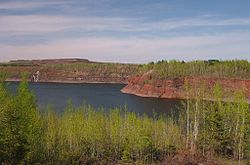United States historic place
| Mountain Iron Mine | |
| U.S. National Register of Historic Places | |
| U.S. National Historic Landmark | |
 Mountain Iron Mine from a city overlook Mountain Iron Mine from a city overlook | |
  | |
| Location | North of Mountain Iron, Minnesota |
|---|---|
| Coordinates | 47°32′20″N 92°37′20″W / 47.53889°N 92.62222°W / 47.53889; -92.62222 |
| Area | 240 acres (97 ha) |
| Built | 1892 |
| NRHP reference No. | 68000052 |
| Significant dates | |
| Added to NRHP | November 24, 1968 |
| Designated NHL | October 10, 1968 |
Mountain Iron Mine is a former mine in Mountain Iron, Minnesota, United States. Opened in 1892, it was the first mine on the Mesabi Range, which has proved to be the largest iron ore deposit ever discovered in the United States. Mining operations at the site ceased in 1956. The bottom of the open-pit mine has filled with water but its dimensions are readily visible. The city maintains an overlook in Mountain Iron Locomotive Park.
Mountain Iron Mine was proclaimed a National Historic Landmark in 1968 and subsequently listed on the National Register of Historic Places for its national significance in the theme of industry. The property was nominated for setting in motion the extraction of iron ore on the Mesabi Range, which helped make Minnesota the nation's largest iron producer and the United States the world's largest steel manufacturer.
History
The discovery of a boulder of high-grade iron ore by Leonidas Merritt in 1887 during a railroad survey prompted he and his brothers to establish the Mountain Iron Mine in 1892. By 1893 the "Seven Iron Brothers" had claims on a significant portion of the Mesabi Range and had built the Duluth, Missabe and Northern Railway (DM&IR). Financial conditions forced them to sell their shares to John D. Rockefeller. Rockefeller later sold his interests to Andrew Carnegie.
The early development was as an underground mine, but open-pit mining soon proved to be a better choice because of the soft, shallow ore deposits. The Mesabi Range and nearby Vermilion Range led Minnesota to become the nation's largest producer of iron ore and the United States to lead the world in steel production. This capacity is considered to have been a major factor in America's ability to contribute to World War II. It also played a major role in the financial success of Andrew Carnegie and U.S. Steel. Carnegie returned some of his fortune to the communities by funding 2,500 public Carnegie libraries across the world, including 64 in Minnesota. The extraction of ore in the region also contributed to the city of Duluth thriving and becoming the leading port in the United States (by tonnage) in the early 20th century.
See also
- List of National Historic Landmarks in Minnesota
- National Register of Historic Places listings in St. Louis County, Minnesota
References
- "National Register Information System". National Register of Historic Places. National Park Service. July 9, 2010.
- "List of National Historic Landmarks by State" (PDF). National Historic Landmark summary listing. National Park Service. p. 53. Retrieved September 4, 2009.
- ^ Lissandrello, Stephen (August 11, 1975). "National Register of Historic Places Inventory--Nomination Form: Mountain Iron Mine". National Park Service. Retrieved December 23, 2018.
{{cite journal}}: Cite journal requires|journal=(help) With 3 accompanying photos from 1975 - "Mt. Iron Locomotive Park". Iron Range Tourism Bureau. 2018. Retrieved December 23, 2018.
- "Mountain Iron Mine (National Historic Landmark)". Minnesota National Register Properties Database. Minnesota Historical Society. 2009. Retrieved December 23, 2018.
- "Merritt Brothers". Minnesota Historical Society. Retrieved December 23, 2018.
- Jones, Theodore (1997). Carnegie Libraries Across America: A Public Legacy. John Wiley & Sons. ISBN 0-471-14422-3.
External links
- Historic American Engineering Record (HAER) No. MN-31, "Mountain Iron Mine, Government Lots 3 & 4, Mountain Iron, St. Louis County, MN", 3 photos, 1 data page, 1 photo caption page
| National Historic Landmarks in Minnesota | |
|---|---|
| Homes | |
| Commercial enterprises | |
| Military | |
| New Deal | |
| Prehistoric | |
| Lighthouse | |
- 1892 establishments in Minnesota
- Buildings and structures in St. Louis County, Minnesota
- Historic American Engineering Record in Minnesota
- Industrial buildings and structures on the National Register of Historic Places in Minnesota
- Iron mines in Minnesota
- National Historic Landmarks in Minnesota
- National Register of Historic Places in St. Louis County, Minnesota
- Open-pit mines
- Surface mines in the United States
- Tourist attractions in St. Louis County, Minnesota

